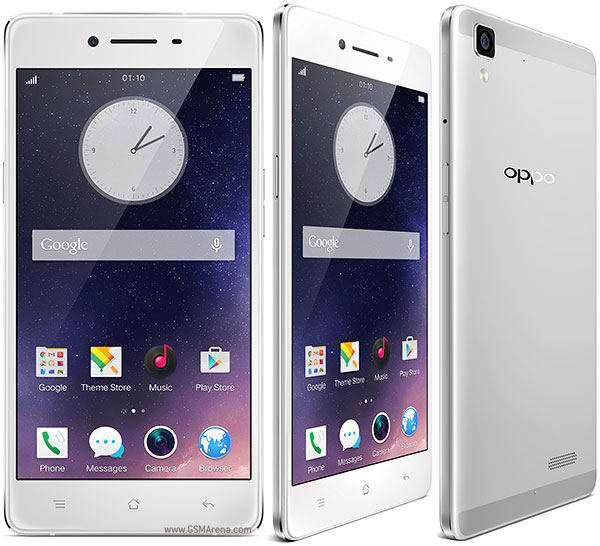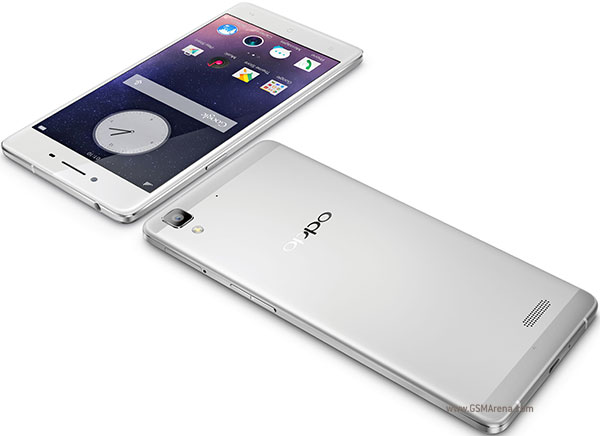Oppo R7 Prices
Important Note.
- All prices are in Pakistani Rupee (PKR)
- Prices may vary at stores and our effort will be to provide you with the updated prices.
- Find out WhatMobile price has dropped in Pakistan by selecting Notify Price Drop button
- Find out WhatMobile has better specifications by clicking Add To Compare Button find out what Mobile has better reviews by visiting our reviews section
- Find out WhatMobile is cheaper on which retailer by clicking Compare prices from retailers button
Search Terms
- Oppo R7
Specifications
| GENERAL | |
| 2G Network | GSM 850 / 900 / 1800 / 1900 - SIM 1 & SIM 2 |
|---|---|
| 3G Network | HSDPA 850 / 900 / 1900 / 2100 - Global, Taiwan HSDPA 850 / 900 / 1700(AWS) / 1900 / 2100 - USA |
| 4G Network | LTE band 1(2100), 3(1800), 7(2600), 8(900), 40(2300) - Global LTE band 1(2100), 3(1800), 5(850), 7(2600), 8(900), 28(700), 40(2300) - Taiwan LTE band 1(2100), 3(1800), 4(1700/2100), 7(2600), 17(700), 20(800) - USA |
| Sim | Hybrid Dual SIM (Nano-SIM/ Micro-SIM, dual stand-by) |
| Announced | 21/05/2015 |
| Status | Available. Released 2015, May |
| BODY | |
| Dimensions | 143 x 71 x 6.3 mm (5.63 x 2.80 x 0.25 in) |
| Weight | 147 g (5.19 oz) |
| DISPLAY | |
| Display Size | 5.0 inches, 67.7 cm2 (~66.7% screen-to-body ratio) |
| Resolution | 1080 x 1920 pixels, 16:9 ratio (~445 ppi density) |
| MultiTouch | Yes |
| Protection | Corning Gorilla Glass 3 - Color OS 2.1 |
| SOUND | |
| AlertTypes | Vibration; MP3, WAV ringtones |
| LoudSpeaker | Yes |
| 3.5mm jack | Yes - Active noise cancellation with dedicated mic |
| MEMORY | |
| CardSlot | microSD, up to 256 GB (uses SIM 2 slot) |
| Internal | 16 GB, 3 GB RAM |
| DATA | |
| GPRS | Yes |
| EDGE | Yes |
| Speed | HSPA, LTE Cat4 150/50 Mbps |
| WLAN | Wi-Fi 802.11 b/g/n, Wi-Fi Direct, hotspot |
| Blue Tooth | 4.0, A2DP |
| USB | microUSB 2.0, USB Host |
| CAMERA | |
| Camera Primary | 13 MP, 4128 x 3096 pixels, Schneider-Kreuznach optics, phase detection autofocus, LED flash |
| Camera Features | Geo-tagging, touch focus, face detection, panorama, HDR |
| CameraVideo | 1080p@30fps |
| CameraSecondary | 8 MP, f/2.4 |
| FEATURES | |
| Processor Cores | Octa-Core |
| OS | Android 4.4.2 (KitKat) |
| CPU | Octa-core (4x1.5 GHz Cortex-A53 & 4x1.0 GHz Cortex-A53) |
| Sensors | Accelerometer, proximity, compass |
| Messaging | SMS (threaded view), MMS, Email, Push Email |
| Browser | HTML5 |
| Radio | No |
| GPS | Yes, with A-GPS, GLONASS |
| Colors | Golden, Silver |
| Others | - Fast battery charging: 75% in 30 min (VOOC Flash Charge) - MP4/H.264 player - MP3/WAV/eAAC+/FLAC player - Document viewer - Photo/video editor |
| BATTERY | |
| Battery | Non-removable Li-Po 2320 mAh battery |
| MISC | |
Reviews

Introduction and design
Oppo isn't a household name in the west, but that probably won't be the case for much longer. Ever since the firm's inception just over a decade ago, the Chinese manufacturer has been renowned for producing high-quality, affordable consumer electronics.
Originally specialising in MP3 and DVD players, Oppo recently moved into the smartphone sector, and has enjoyed booming success in mainland China.
Groundbreaking devices such as the Find 5, N1 and R5 have propelled Oppo into the global spotlight, and like many other Chinese smartphone manufacturers the brand is also beginning to gain traction in international markets.
Rather than being something totally unorthodox, the newly released Oppo R7 is more of a refined sequel to the paper-thin R5 – and isn't to be confused with the phablet variant of the R7, the R7 Plus, which was also launched during Oppo's 10th birthday celebrations in May.

Although most official stores and other partner retailers are located in Asia, you can pick up a SIM-free R7 online. Oppo sells directly via both Amazon and Oppostyle, and the R7 is currently available for just £250 (around $400, AU$515).
While ultimately not as powerful as beefier rivals such as the OnePlus One and Honor 6, and despite the fact that it's missing the fingerprint scanner from the R7 Plus, the Oppo R7 still packs some impressive specs.
Oppo has included a Qualcomm Snapdragon 615 Octa-core processor, an Adreno 405 GPU and a hefty 3GB of RAM – 1GB more than the R5. The front-facing shooter has received a resolution bump to 8MP, and the rear 13MP unit now derives from Samsung, rather than Sony.
'VOOC Flash Charge' technology is once again on board, enabling the R7's relatively small 2320mAh battery to charged to 75% in just half an hour. Unfortunately there's still no NFC, but Oppo has included dual-SIM 4G LTE connectivity.
Akin to the Samsung Galaxy A3, the Oppo R7's all-metal design is what sets it apart from other mid-range offerings. In terms of look and feel the R7 really does surpass all expectations for an affordable smartphone, and almost everything seems more refined than on the R5.
At first glance the front of the Oppo R7 looks extremely similar to the R5, partly thanks to the retention of Oppo's physical navigation keys below the display.
Up top things look a little less lopsided, with the improved 8MP front-facing snapper moving to the left of the central earpiece while the proximity and ambient light sensors remain on the right.
Hidden beneath the front glass is an LED notification light that's only visible when illuminated. Unfortunately, as on the Moto G (2014) it's of the white variety, so you won't be able to differentiate between notification types without firing up the display.
The bottom edge looks almost identical to that of its predecessor, with two antenna bands flanking the centrally positioned microUSB port and single microphone.
Gazing at the Oppo R7's Full HD screen is a real pleasure, it's one of the best examples on an affordable handset.
A high pixel density of 445ppi makes for crisp-looking text and images, and the inclusion of AMOLED display technology is very welcome. Vivid colours and wide viewing angles combine with an extensive brightness range to create a stellar viewing experience, regardless of lighting conditions.
This impressive screen also features Oppo's '2.5D Arc Edge' design, whereby the glass gently tapers off at the edges, resulting in a pleasant-looking droplet effect. Unfortunately the R7's metal frame interrupts the flowing glass at the very edge, preventing you from fully appreciate the innovative design.
Unusually, the metallic power button is located on the left-hand side. While that may sound problematic, the key is easily accessible with your middle finger if you're right-handed and lefties will find the key perfectly positioned for their thumb. You can double-tap the screen to wake the phone, or the home button to sleep it if you prefer, although you will miss out on the great tactile feedback.
Like the power key, the volume rocker on the right edge feels very premium. That said, being right-handed I often found myself hitting the volume keys with my thumb by accident when gripping the R7.
Oppo has implemented a nifty 4G dual-SIM and microSD setup in order to keep the sides of the R7 clean. The tray located above the volume rocker can hold one microSIM and nanoSIM, although if you wish to expand the 16GB of internal storage by up to a further 128GB you'll have to swap out the nanoSIM for a microSD card.
Last year's R5 was compromised in multiple ways, and the omission of a 3.5mm headphone jack was arguably the most notable example. Thankfully you won't need to use a pesky microUSB-to-headphone adapter with the R7, as Oppo has managed to cram a 3.5mm jack into the slightly thicker frame.
Despite the Oppo R7 featuring a modest 5-inch screen, the inclusion of physical navigation buttons at the bottom results in a rather tall device. A degree of dexterousness may be needed to reach the top corners of the display, although the well-positioned buttons help to minimise in-hand shuffling.
For such an affordable offering the full metal unibody construction of the Oppo R7 is incredible, exhibiting absolutely no signs of creaking or flexing. The quality of the fit and finish is right up there with flagships such as the iPhone 6 and HTC One M9, which cost almost twice as much.
The smooth metal rear is subtly stylish and pleasantly cool to the touch. At the top-left there's a 13MP rear snapper, which thankfully protrudes far less than the unit found on the R5. Underneath sits the single LED flash, with the noise-cancelling microphone taking up a slightly off-centre position above the Oppo logo.
Both the silver and gold variants of Oppo R7 adopt a matte finish around back, which does a good job of resisting fingerprints. In stark contrast to many metal smartphones the rounded-off corners on the back don't dig into the palm, and the chamfered metal frame provides plenty of grip.
Key features and interface
Arguably the Oppo R7's standout feature is its design. As discussed in the first section of this review, the build quality is superb and it feels lovely in the hand.
Oppo also touts the prowess of both the main 13MP camera and 8MP front-facing shooter, which I'll look at more closesly in the camera section of the review.
While more and more manufacturers have been adopting Qualcomm's 'Quick Charge' technology, Oppo has been busy perfecting its own alternative: 'VOOC Flash Charge', which was first introduced with the Find 7 and is designed to provide a safe and fast charging experience.

The Oppo R7 is the latest device to support this technology, with the Chinese firm claiming that five minutes on the supplied rapid charger will give you enough juice for a two-hour phone call, and that charging the battery from 0 to 75% can be achieved in just half an hour. In practice I was consistently able to reach over 70% within the allotted time, a quite remarkable feat.
Being a Chinese smartphone, it's not surprising that the R7 includes dual-SIM functionality. Only a handful of devices designed in the west, such as the Moto G (2014), support this feature. Yet in Asia and other developing markets this feature has been available for some time, even on the cheapest of handsets.

I can see why the feature is so highly sought-after in certain parts of the world. It's extremely convenient if you normally have to carry around separate work and personal phones, while regular international travellers and business people will also appreciate not having to swap SIM cards every few days.
2G, 3G and 4G LTE are usable on both SIM cards, which will certainly appeal to heavy data users, although when you select one SIM to use either 3G or 4G LTE, the other is automatically limited to just 2G.
US and international versions of the R7 are available, so users residing in the States and Australia shouldn't have a problem accessing 4G LTE networks. Unfortunately none of the R7 variants support band 20 LTE, so those in the UK who are on O2, giffgaff or Tesco Mobile won't be able to receive any 4G signal.
Color OS 2.1, Oppo's customised version of Android, is preinstalled on the R7. For some reason the Chinese firm decided to release the newer Android Lollipop-based software exclusively for the larger R7 Plus, leaving the R7 stuck on 4.4.4 KitKat.
However, on the face of it there seems to be very little difference between the two software versions, and I'm hopeful that the R7 will receive the Android 5.1 update in the near future.

The latest Color OS 2.1 upgrade brings improved aesthetics and a host of new features.
In general the icons and menus exhibit a flatter, more refined look than before. Stock widgets, such as the clock, now appear slightly transparent, and the music space to the left of the central homescreen has also received a facelift.
Likewise, all of the R7's key apps are very similar to what was present on the R5, but have been slightly tweaked to be more visually coherent.
As is the case with the majority of Chinese custom UIs, Color OS 2.1 still doesn't feature an app drawer. For first-time smartphone users and those switching from an iPhone, this omission arguably makes navigating around the OS a little simpler.
Android veterans on the other hand will probably dislike the multitude of app icons and folders taking up precious widget space on the R7's homescreens.
One folder that will be a welcome sight is the one containing key Google apps like Gmail, Chrome and Maps. Other than the variants sold domestically in China, all R7s are shipped with the Play Store and Google Services preinstalled.
From previous experience of owning imported Chinese smartphones, I know how much of a chore it can be to get these installed and running smoothly. So being able to use them straight out of the box is a real blessing.

Despite many lacking Google apps, devices from China do tend to offer a multitude of customisation options.
A Theme Store app is present on the international Oppo R7, but it's a watered-down version of the one found on the Chinese variant. There are fewer themes available, and the ones that are included aren't as polished.
That being said, the themes are far from the worst I've seen, and the app still enables you to change the look of the icons, folders, lockscreen and wallpaper.
Hopefully the 'Mash Up' feature from the Chinese Theme Store will soon be rolled out globally, as currently you can't combine elements from different themes.
In spite of the lack of aesthetic customisation options, Oppo hasn't tried to compensate by adding tons of gimmicky software features. In fact, in the gesture and motion department the Chinese firm have removed the finicky air gestures, opting to focus its attention on 'Screen off' and 'Screen on' gestures.
A number of customisable letter-based gestures are available when the R7's in sleep mode. These enable you to either jump straight into an app of your choice, or control your music while the screen is off.
The much-loved double-tap to wake feature is also here and, instead of having to reach for the power key, a quick double-tap of the home key will sleep the R7's display.
Luckily for those who find accessing some areas of the R7's screen a bit of a challenge, a handy 'Mini-screen' mode can be activated via a simple gesture. Swiping into the centre of the display from either of the bottom corners shrinks whatever's on the screen, and pulls it closer to your preferred hand.
Performance and essentials
Performance
At the heart of the Oppo R7 you'll find a 64-bit 1.5Ghz Qualcomm Snapdragon 615 octa-core processor, an Adreno 405 GPU and 3GB RAM –1GB more than its predecessor.
The R7 may struggle to compete against the latest crop of high-end offerings, but it certainly punches well above its weight. For an affordable smartphone these specs are mightily impressive, and should enable the R7 to keep pace with powerful mid-range rivals such as the Oneplus One.
Sure enough, consistently high Geekbench 3 multi-core test results show that the R7 is right up there with some of the most capable handsets in its price category.
An average score of 2,755 puts the R7 considerably ahead of most similarly-priced devices like the Alcatel OneTouch Idol 3 (2,066), with it only just losing out to the mighty OnePlus One (3,050) and Honor 6 (3,148). Oppo's latest offering also outperforms the R5 (2,644) and produces a comparable score to 2014 flagships such as the HTC One M8 (2,899).

In real-world use, navigating through Color OS 2.1 on the R7 is a breeze. There's no sign of any stutter or lag anywhere in the UI and the 3GB RAM ensures multitasking is managed competently.
With the latest software update, Oppo has included a multitude of optimisations and it really shows. Apps load up almost instantaneously, and with a low crash rate of 0.3% they stay open for as long as you need them to.
If you enjoy casual gaming on the go the R7 won't disappoint, and popular titles such as Temple Run 2 and Crossy Road run incredibly smoothly. More graphically-intensive games, such as Real Racing 3, are handled adequately, although the R7's thin metal unibody does have a tendency to heat up rather rapidly.
Battery life
Crammed into the 6.3mm-thick Oppo R7 is a non-removable 2320mAh battery. Despite not being particularly large for a 5-inch device, it's a welcome upgrade from the paltry 2000mAh cell found in the thinner R5.
Software enhancements and the inclusion of the power-efficient Snapdragon 615 processor and AMOLED display help to conserve juice, resulting in acceptable, if not remarkable, battery life.
Light-to-moderate users will make it through the day without too much difficulty, and four to five hours of screen-on time is achievable on a single charge. That being said, media fanatics and heavy users of the R7's dual-SIM feature may have to reach for the VOOC charger before the day is out.

Thanks to its power-efficient internals the R7 performed fairly well in the techradar HD video test. After playing the 90-minute clip, with brightness and volume levels set to maximum, the R7's battery only depleted by 25% – that's 2% better than the Acer Liquid Jade S and Oppo R5, and 1% better than the Google Nexus 5.
Unfortunately the R7 doesn't fair so well against the some of its biggest mid-range rivals. The OnePlus One still had 83% juice left after completing the test, and the ZTE Blade S6 only lost 16% over the course of the clip.
Unlike those last two competitors, however, the Oppo R7 is currently using Android 4.4.4 KitKat as a base, rather than Lollipop. Unlike Google's latest OS, KitKat is not fully optimised to support 64-bit processors like the Snapdragon 615, and so there's potential for battery life to improve after the R7 receives an update to Android 5.1.
If the R7's battery is in the red and you can't get to a power outlet, you'll have to resort to using the included 'Normal' and 'Super' power-saving modes. The ability to customise the 'Normal' mode is a nice touch, enabling you to freeze background apps, disable animations and underclock the CPU.
The 'Super' mode works in much the same way as the 'Ultra power saving' mode on Samsung devices. The majority of smartphone functions are limited, leaving you with access only to the dialer, contacts, messages and clock – so unless you're really desperate to conserve power, you'll probably want to avoid using this feature.
The essentials
The Oppo R7 is a wonderfully designed device packed full of innovative features, but that doesn't mean the Chinese firm has neglected the essentials.
Although the majority of smartphones nowadays are perfectly capable of providing a decent calling experience, the R7 is one of the more competent devices I've used.
Sound during calls is rich through the earpiece, and the combination of a quality pair of microphones ensures that your voice comes through clearly, even in the loudest of environments.
Rear-firing speakers aren't usually up to much, but the unit on the R7 is an exception. I was pleasantly surprised by how crisp calls sounded over the speakerphone, and thanks to an almost deafening maximum volume level you won't need to rely on the vibrate function to know when you've got a call or notification.

There's nothing flashy about the key apps on the R7, yet Color OS 2.1 provides the core smartphone features in a simple and straightforward manner.
'Easy dial' is available in the phone app, giving you a quick way of sifting through your contacts list and placing a call. Narrowing down your search to a specific individual also gives you the option to fire off a text message or view detailed contact information.
Oppo's contact management system is comparable to that found on Samsung devices, which is a definite plus. Contact details can be hauled in from numerous sources, including Google, email accounts and installed social networking apps, enabling you to store them in one convenient place.
Two SMS options are baked into the R7's software, the default Messages app and Google Hangouts.
I'm not usually a fan of stock messaging apps, but I was pleasantly surprised by Oppo's offering. It elegantly incorporates dual-SIM functionality, and the pop-up feature is really handy for replying to texts without having to dive into the app itself.
If you're deeply integrated with Google services and want a more of an ecosystem-centred experience, then you may want to switch to Hangouts. However, for the average user the stock messaging app will be more than adequate.

Regardless of the messaging app, you'll enjoy typing on the included Swype keyboard. As you'd expect from such a popular board the keys are nicely spaced, gesture typing is fluid and autocorrect is pretty reliable.
Numerous languages can be downloaded in the keyboard settings and, once configured, are easily accessible via the spacebar. Unfortunately not all of them are supported by Swype's neat bilingual typing feature, which simultaneously shows word predictions for two different languages.
With a beautiful 5-inch 1080P AMOLED display, slim design and 4G LTE connectivity, the R7 is tailor-made for light web browsing on the go. Websites are quick to load, whether you're using Google Chrome or the stock browser, and scrolling is buttery smooth.
If it wasn't for history and bookmark syncing in Chrome I'd solely use the stock browser, as Oppo's internet app includes reader-friendly full-screen and night modes.
Media fanatics who prefer watching videos or listening to music won't be disappointed either. The R7's display is an all-round strong performer and, as you'd expect from a company that makes audio equipment, sound quality is superb through both the rear-facing speaker and 3.5mm headphone jack.
Camera
Oppo has given the R7's cameras a big build-up, promising excellent performance, and on paper the specs look impressive for a mid-range device.
Around the back there's a 13-megapixel primary shooter coupled with single LED flash, and on the face of the R7 sits a front-facing camera packing an 8MP OmniVision sensor.
Unfortunately, photos taken with the R7's rear shooter are generally disappointing. They're far from terrible, with 'Ultra HD' mode enabling you to capture a decent amount of detail, but colours lack vibrancy and whites often appear washed out.
By default the resolution of the R7's camera is limited to 10MP, enabling the app to use a 16:9 wide-angle viewfinder. If you want to maximise image quality you'll have bump up the resolution to the full 13MP, and live with a boxy 4:3 aspect ratio.
Navigating around the camera UI is pretty straightforward and, despite being packed full of features, the app retains a minimal aesthetic like the rest of Color OS 2.1.
Akin to the software found on the Sony Xperia Z3+ and Samsung Galaxy S6, plenty of customisable shooting modes are included, and more can be downloaded from the R7's camera shop.

Essentials such as 'HDR', 'Panorama' and 'Colorful night' are present, and 'expert' mode' gives you full manual control over core camera functions. The ability to shoot in raw format is also handy, and social media fanatics will probably appreciate the inclusion of fancy filters.
'Ultra HD' mode enables you to achieve up to 50MP snaps with the R7's camera, by taking four photos and merging them together. Results are sharper than when shooting in other modes, although this feature does require extra processing time.
More unusual modes like 'Beautify', 'Super Macro' and 'Slow Shutter' are fun to play around with in certain situations, but in everyday use I didn't find myself switching out of 'Normal' mode too often.
In general, snapping photos with the R7 is fast and enjoyable. The camera app launches in less than a second thanks to Oppo's optimisations, thus improving your chances of bagging that crucial shot.
Autofocus speeds are also good, and there's almost zero shutter lag, so you probably won't ever need to dive into camera settings to enable burst mode.
Even with a fantastic camera app, however, the Oppo R7's 13MP rear snapper can only deliver middling image quality if 'Ultra HD' mode isn't enabled.
In well-lit conditions you can take some adequate shots, but images do tend look a tad soft, and a fair amount of background noise is visible upon close inspection. Colours also seem slightly dull, but 'HDR' mode is available to make the things a bit more vibrant.

Click here for the full-resolution image
Thankfully close-up snaps are significantly more detailed. The depth of field isn't particularly shallow, yet subjects are still prominent thanks to the slightly blurred background.

Click here for the full-resolution image
Even when using the bundled 'Colorful night' and 'HDR' modes, the R7 performs poorly in low-light conditions. Regardless of the mode you're shooting in, a high ISO has to be used as the f/2.2 lens struggles to take in enough light, and so grainy photos are the norm.

Click here for the full-resolution image
On the plus side, the Oppo R7's main camera records crisp and detailed 1080P video at 30 frames per second. Colours are still not well saturated, but the camera adjusts to changing light conditions quickly and smoothly.
While the R7's primary camera under-achieves, the 8MP front-facing shooter is a decent performer, and it's certainly a cut above the units found on most affordable handsets. Detailed selfies, and the ability to record 1080P, should satisfy even the most demanding of socialites.
Verdict
The Oppo R7 improves upon its predecessor in almost every way, bringing impressive performance, premium design and innovative features into the mid-range smartphone market.
We liked
With its attractive full-metal unibody design and flagship-level build quality, the Oppo R7 is one of the most premium mid-rangers currently available. The 5-inch form factor, chamfered frame and smooth rear combine to produce a great in-hand feel, and the inclusion of 2.5D glass around the front is also a classy touch.
Beneath that futuristic glass is a bright 5-inch AMOLED display, which delivers vibrant colours and insanely wide viewing angles. Consuming media on the R7 is a real treat, and the power-saving nature of the panel helps to maximise battery life.
Day-to-day performance is also superb, thanks to optimised software and powerful internals. Navigating through the Colour OS UI is super-smooth, and even graphically intensive gaming fails to bog the R7 down.
Although battery life is far from terrible, heavy users will greatly appreciate the R7's VOOC flash-charging feature. Being able to charge from empty to over 70% in just 30 minutes is pretty mind-boggling, and potentially negates the need to carry around a hefty power bank.
We disliked
Dual-SIM 4G LTE is without doubt one of the R7's more notable features, one that is extremely convenient for frequent travellers and business people. However, the absence of band 20 LTE will be a real shocker for many people residing in the UK. If you're on O2, giffgaff or Tesco Mobile you won't be able to receive any 4G signal, and that's a potential deal-breaker.
Color OS won't appeal to everyone, and the lack of an app drawer will deter many an Android purist. Surprisingly the software running on the R7 is based on the a dated version of Android, 4.4.4 KitKat, rather than the latest 5.1 Lollipop found on the R7 Plus. Considering the potential performance upgrades that Lollipop could bring, it's disappointing not to see the latest software on a recently launched device.
Despite the impressive camera app and ISOCELL technology, the R7's 13MP rear shooter produces average results when you're not using the 'Ultra HD' mode. Images tend to appear under-saturated, and the camera struggles with exposure in bright conditions. It's far from the worst camera on a mid-range smartphone, but it should still be performing a little better.
Final verdict
With the R7, Oppo has achieved its goal of producing a powerful yet affordable smartphone that features a premium all-metal unibody construction.
Bucking the trend somewhat, the R7 has attracted no price markup outside of China, making it an absolute steal.
In terms of functionality it offers far more than last year's R5, without most of the compromises. It may not possess the immediate wow factor of its predecessor and the N3, or the sheer power of the Honor 6, but it's still a fantastic all-round performer.
If you're looking a premium-feeling, stylish and powerful handset that won't break the bank, then the Oppo R7 may well be the one for you.
Write Your Own Review
My Recent Reviews
- Be first to post review for this product.
comments powered by Disqus




























